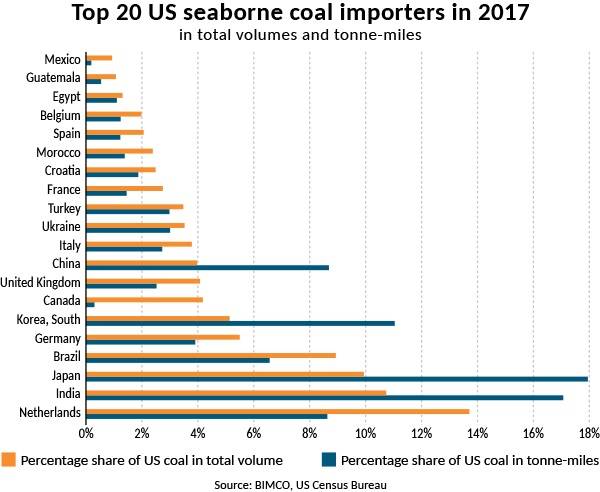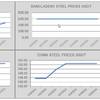U.S. seaborne coal exports have turned years of negative growth around and seem to be climbing for a third quarter in a row. The increase in total volume is predominantly driven by a growing demand from European importers. East Asian buyers have also ramped up their import of U.S. coal, which is beneficial for the dry bulk shipping industry as it generates a substantial amount of ton-miles, relative to other destinations.
BIMCO reported back in December 2016, that the ton-miles from U.S. coal exports halved over three years due to long-haul routes carrying coking coal to East Asia not operating to the same extent and diminishing demand from Europe. After reaching the lowest levels for exported coal in Q3 2016 since Q1 2007 in terms of total volumes, US coal exports now look to return to recognizable heights and become a dominant player in global seaborne coal transport once again.
BIMCO’s Chief Shipping Analyst, Peter Sand, commented,” A rising U.S. coal trade has a multiplying effect on the dry bulk shipping industry, as it provides some of the longest sailing distances. East Asian importers source 78 percent of their U.S. coal from Norfolk, Va. and Baltimore, Md. and thereby accept a journey of up to 45 sailing days at an average speed of 13 knots (14,000 nautical miles)”.
U.S. coal exports are up 54 percent in total volume and 60 percent in terms of ton-miles for the first five months of 2017 compared to the same period last year. As the average sailing distance has grown more than total volume, it emphasizes how the U.S. has exported more to importers further away, primarily to East Asian destinations.
Europe imports the highest volume while East Asia generates the most ton-miles
The main importers of U.S. coal for the first five months of 2017 are the Netherlands, India and Japan, importing 34 percent of all coal exiting the U.S. via the sea. The most influential importers for the dry bulk shipping industry are India, Japan and South Korea, generating 46 percent of total ton-miles.
Europe continues to be the largest importer of U.S. coal and has for the first five months of 2017 imported 44 percent of all U.S. seaborne coal exports. Europe has sourced 4.7 million metric tons more coal from the U.S. in the first five months of 2017 compared to the same period in 2016, which is an increase of 53 percent. U.S. coal exports to Europe occupies both the panamax and capesize segment.
The Netherlands have, in the last 10 years, been the main importer of US coal both in Europe and on a global scale. Due to its shorter distance to the U.S. East Coast compared to East Asian buyers, it has in the past 10 years only generated the fifth highest number of ton-miles.
East Asian importers are the main reason why ton-miles are growing more than total volume, despite only 19 percent of total U.S. seaborne coal exports destined for East Asia in 2017. The East Asian imports of U.S. coal surged 113 percent in the first five months of 2017 compared to 2016, amounting to an increase of 3.1 million metric tons. U.S. coal shipments to East Asia generated 92 percent more ton-miles in the first five months of 2017 compared to the same period in 2016. Japan is the most influential importer in terms of ton-miles across the board, but it is only the seventh biggest importer on a global scale measured in volumes imported.
The Americas imported an additional 21 percent of U.S. seaborne coal during the first five months of 2017 compared to the same period in 2016. This surge in total volume generated an additional 24 percent ton-miles. The Americas have so far for 2017, imported 17 percent of all U.S. coal exported via sea, but due to the geographical proximity to U.S. ports, the Americas only generated 9 percent of the total ton-miles.
Higher U.S. coal production but still close to lowest level since 1978
The US have produced 351 million metric tons of coal in the first half of 2017, this is an increase of 16 percent compared to the same period last year, amounting to an increase of 49 million metric tons. This year-on-year increase does not indicate a high production level compared to years prior to 2016, as the amount of coal produced in 2016 was the lowest level since 1978.
U.S. coal consumption numbers released so far only cover the first four months of 2017, but show an increase of 6 percent compared to the same period in 2016. The production of U.S. coal rose 16 percent in the same period. This amounts to a surplus of 32 million metric tons of coal for the first four months.
Sand added, “BIMCO expects Q2 2017 to go beyond the levels seen in Q1 2017 in terms of ton-miles and deliver the highest second quarter demand in four years.
“If U.S. coal exports remain high throughout 2017 it will have a solid effect on the global seaborne coal trade and support the overall improvement in the dry bulk shipping industry.”

















